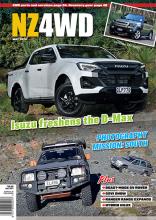The Chrysler-Jeep personnel had a problem that most car companies dread on a product launch. The plane carrying the bulk of their Australian guests had broken down, delaying the start of the Australasian Jeep Patriot launch in Queenstown. What were they going to do with the Kiwis and some Aussie media types already gathered in the Heritage Hotel? One smart Jeep staff member had a brainwave: Let’s go and play with the two Jeep Rubicon’s (brought down as support vehicles) in a Queenstown slate quarry and show these media folks what they can do on and off-road. What seemed like a great idea wasn’t the most popular move with some media who were decidedly not amused at being bussed out to a cold and damp shale quarry located behind one of Queenstown’s many wineries. However the Jeep people decided this was an opportunity to showcase the Rubicon’s ability to a captive audience, whether they liked it or not. So that’s how these interesting pictures came about, while some members of the party grumbled about being dragged out of the nice warm Heritage Hotel to stand in the cold (it was 5 degrees), yours truly decided to enjoy having a go at trying out the Rubicon on some very challenging territory around the quarry. Our presenter for this impromptu “show and tell” was Jeep product manager Kevin Tourneur from the USA. Even the well-travelled Tourneur admitted it was cold in the confines of the quarry but nevertheless he soldiered on with a detailed brief about the engineering behind the new Wrangler Sport, Sahara and Rubicon variants. The new two-door Wrangler Rubicon remains the iconic Jeep despite considerably changing from the previous model. However several Wrangler design cues such as hallmark seven-slot grille, round headlamps, trapezoidal wheel flares and an upright rectangle windscreen remain. Interior comfort for driver and passengers benefits from the growth of the Wrangler body which is 34 cm longer and 1 cm wider than before, as well as the wheelbase growing 5.2 cm in length. This translates into more legroom for rear passengers and improved luggage space, plus extra shoulder and hip room for all occupants. There’s even a hidden storage space in the rear cargo area for valuables and accessories. Both the silver and burgundy Rubicons pictured here were equipped with the new 3.8-litre V6 petrol engine which has 146 kW of power and 315 Nm torque. The Wrangler comes standard with a six-speed manual transmission but these two were fitted with automatic transmission which made for an easy job of leaping up and down the slate covered mounds around the quarry. The 3.8-litre V6 petrol engine produces more power and torque than the prior 4-litre inline 6-cylinder petrol engine, and maintains higher torque at speeds above 3,400 rpm, allowing for an expanded operating range on-road and off. Thankfully the fuel economy figures are also improved over the previous petrol engine. For demanding off-road conditions the Jeep Wrangler Rubicon model features an Off-Road Rock-Trac NV241 two-speed transfer case with a 4.0:1 low-range gear ratio, as well as electric front- and rear-axle lockers for extreme off-road conditions as well as an electronic sway bar disconnect, improved suspension and tougher tyres to enable this model to conquer the most demanding terrain. Even though most of the journalists assembled were not experienced 4WDers, they (like me) found that both the Rubicons leapt around the Queenstown quarry like the proverbial pair of wild alpine goats. Certainly the ability to unlock the sway bar as well the front and rear axles of the Rubicon inspired confidence in the cold and slippery conditions. Retaining its classic appearance, the Wrangler still has its signature exposed hardware including bonnet latches, folding windscreen bumpers and a footman loop. Forged door and windscreen hinges are also exposed and feature a precise, modern and machined appearance. The diehard Jeep fans will be pleased by this I am sure. For the first time in the Wrangler lineage the new Rubicon features a curved windscreen – meeting a key objective to reduce wind resistance and improve interior sound levels. In addition, the interface between the windscreen and the top is repositioned to improve airflow, reduce wind noise and create a better weather seal. Flanking the grille on all Wrangler models are all-new headlamps that are sealed and feature a 20 percent brighter halogen bulb. Below the grille is a new blow-moulded bumper with integrated fog lamps (on Sahara and Rubicon models only). The bumper provides improved energy absorption and, combined with a new air dam and better aerodynamics. The Wrangler’s flat clamshell bonnet intersects new trapezoidal fender flares, which appear as separate fender components – similar to some of the first civilian-model Jeep vehicles. More resistant to dents and corrosion, the new fenders are bolted on and may be removed for people to customize the vehicle to meet their needs. Full-framed doors (half doors are not available in the New Zealand market) are removable and feature available power windows and door locks – a Wrangler first. Doors include traditional check straps, which also house wiring for optional power door features. The Wrangler offers new blow-moulded step assists that are mounted to the body and feature a diamond plate texture on the surface (available for Sport, standard for Sahara). For added body protection, Jeep Wrangler Rubicon models come standard with heavy-duty rock rails. Wrangler Rubicon $47,990; auto $49,990. Wrangler Ltd Rubicon $52,990; diesel $55,990
Wrangling in a Rubicon
Tuesday, 30 October 2007


